GIGABYTE Z87X-OC Review: Overclocking Oriented Orange at $200
by Ian Cutress on October 11, 2013 10:00 AM EST- Posted in
- Motherboards
- Intel
- Gigabyte
- Z87
Readers of our motherboard review section will have noted the trend in modern motherboards to implement a form of MultiCore Enhancement / Acceleration / Turbo (read our report here) on their motherboards. This does several things – better benchmark results at stock settings (not entirely needed if overclocking is an end-user goal), at the expense of heat and temperature, but also gives in essence an automatic overclock which may be against what the user wants. Our testing methodology is ‘out-of-the-box’, with the latest public BIOS installed and XMP enabled, and thus subject to the whims of this feature. It is ultimately up to the motherboard manufacturer to take this risk – and manufacturers taking risks in the setup is something they do on every product (think C-state settings, USB priority, DPC Latency / monitoring priority, memory subtimings at JEDEC). Processor speed change is part of that risk which is clearly visible, and ultimately if no overclocking is planned, some motherboards will affect how fast that shiny new processor goes and can be an important factor in the purchase.
For reference, the Z87X-OC does enable MCT and thus we get the full 40x multiplier on our i7-4770K at any CPU load (except idle).
Point Calculations - 3D Movement Algorithm Test
The algorithms in 3DPM employ both uniform random number generation or normal distribution random number generation, and vary in various amounts of trigonometric operations, conditional statements, generation and rejection, fused operations, etc. The benchmark runs through six algorithms for a specified number of particles and steps, and calculates the speed of each algorithm, then sums them all for a final score. This is an example of a real world situation that a computational scientist may find themselves in, rather than a pure synthetic benchmark. The benchmark is also parallel between particles simulated, and we test the single thread performance as well as the multi-threaded performance.
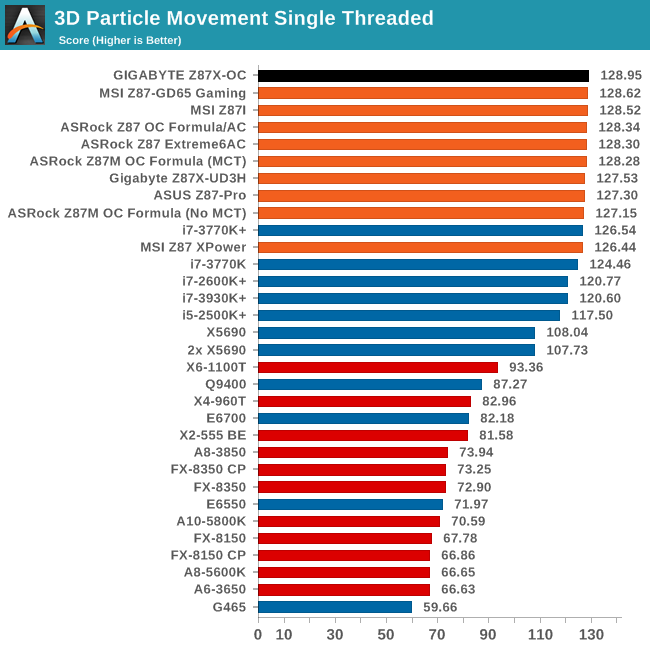
The 3DPM-ST test is often a good indicator of pure efficiency in floating point loads. The GIGABYTE Z87X-OC scores the best result we have seen with Z87 on this test.
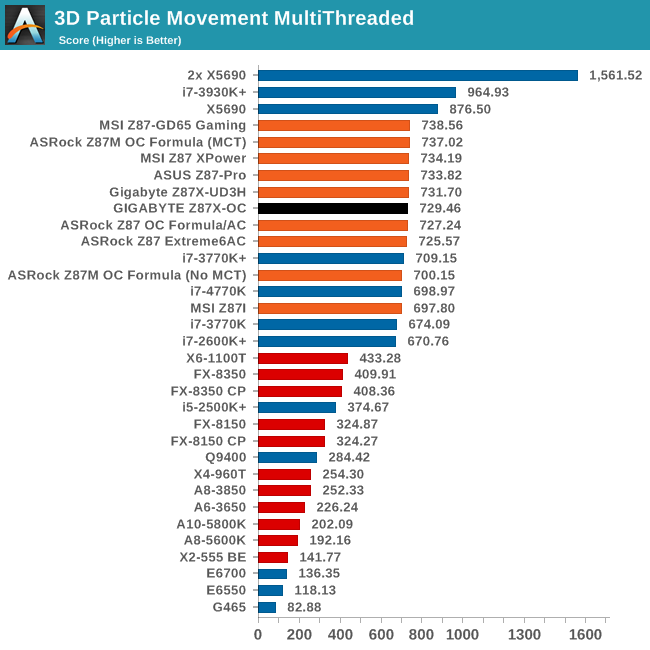
3DPM does not scale perfectly with threads, but Intel processors have the tools to deal with eight floating point calculations at once. The GIGABYTE seems not to retain the efficiency from the single threaded test, but still scores indicative of an MCT enabled motherboard.
Compression - WinRAR 4.2
With 64-bit WinRAR, we compress the set of files used in the USB speed tests. WinRAR x64 3.93 attempts to use multithreading when possible, and provides as a good test for when a system has variable threaded load. WinRAR 4.2 does this a lot better! If a system has multiple speeds to invoke at different loading, the switching between those speeds will determine how well the system will do.
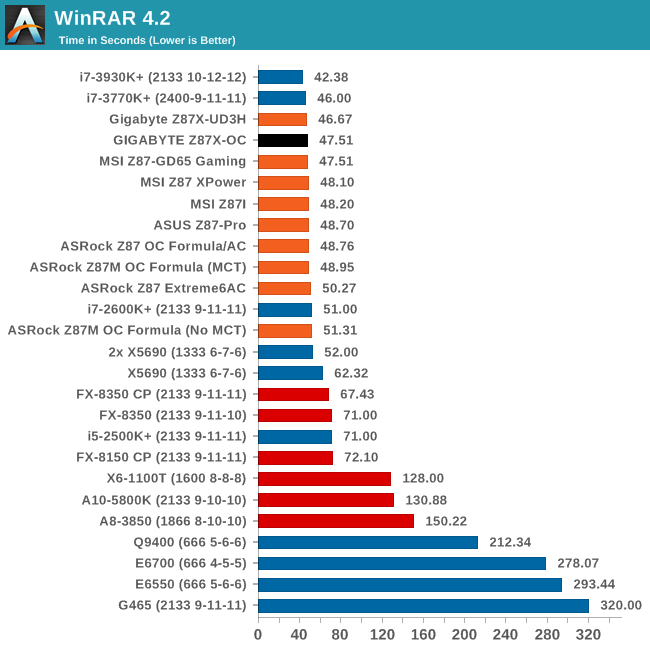
GIGABYTE motherboards are taking the top Z87 ranks in our WinRAR test which usually rewards memory efficiency as well as CPU efficiency.
Image Manipulation - FastStone Image Viewer 4.2
FastStone Image Viewer is a free piece of software I have been using for quite a few years now. It allows quick viewing of flat images, as well as resizing, changing color depth, adding simple text or simple filters. It also has a bulk image conversion tool, which we use here. The software currently operates only in single-thread mode, which should change in later versions of the software. For this test, we convert a series of 170 files, of various resolutions, dimensions and types (of a total size of 163MB), all to the .gif format of 640x480 dimensions.
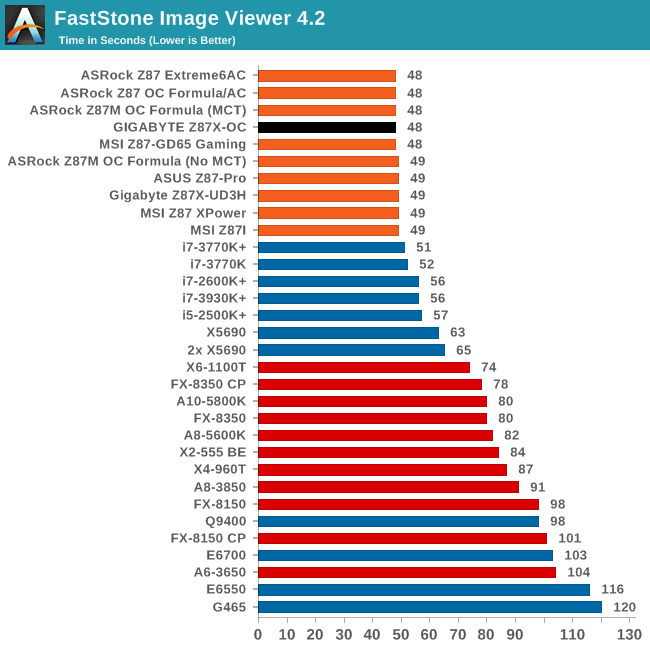
No surprises with Faststone - all Z87 motherboards scoring 48-49 seconds.
Video Conversion - Xilisoft Video Converter 7
With XVC, users can convert any type of normal video to any compatible format for smartphones, tablets and other devices. By default, it uses all available threads on the system, and in the presence of appropriate graphics cards, can utilize CUDA for NVIDIA GPUs as well as AMD WinAPP for AMD GPUs. For this test, we use a set of 33 HD videos, each lasting 30 seconds, and convert them from 1080p to an iPod H.264 video format using just the CPU. The time taken to convert these videos gives us our result.
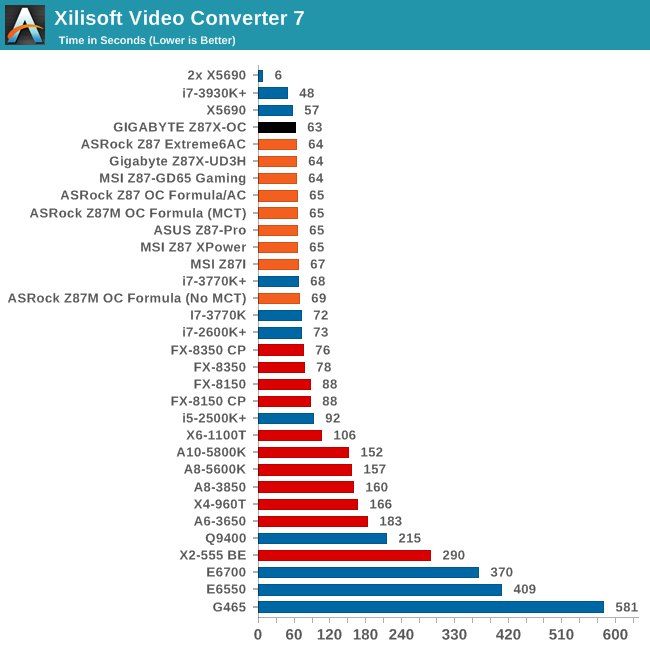
The Z87X-OC manages to pull out a small lead over the other Z87 motherboards in this test, and four seconds (6.3%) over the MSI Z87I.
Rendering – PovRay 3.7
The Persistence of Vision RayTracer, or PovRay, is a freeware package for as the name suggests, ray tracing. It is a pure renderer, rather than modeling software, but the latest beta version contains a handy benchmark for stressing all processing threads on a platform. We have been using this test in motherboard reviews to test memory stability at various CPU speeds to good effect – if it passes the test, the IMC in the CPU is stable for a given CPU speed. As a CPU test, it runs for approximately 2-3 minutes on high end platforms.
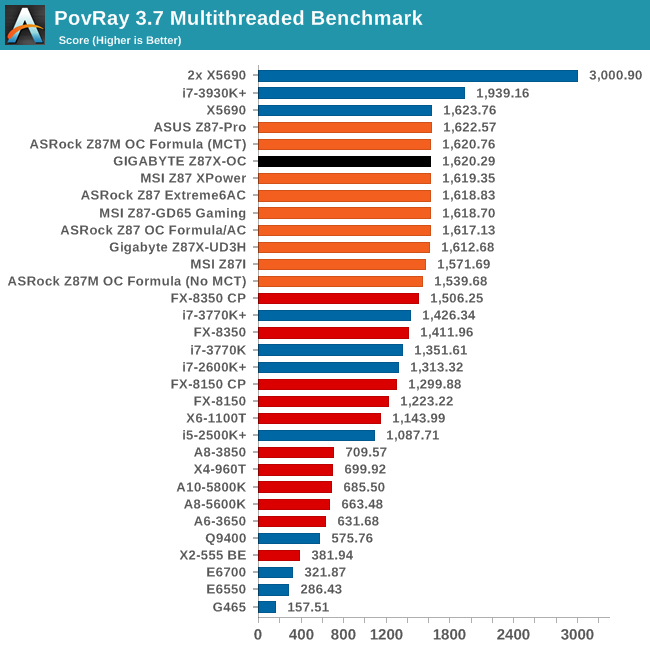
PovRay is another indicator of what systems can keep a top speed sustained - here the GIGABYTE seems unflustered by any background processes.
Video Conversion - x264 HD Benchmark
The x264 HD Benchmark uses a common HD encoding tool to process an HD MPEG2 source at 1280x720 at 3963 Kbps. This test represents a standardized result which can be compared across other reviews, and is dependent on both CPU power and memory speed. The benchmark performs a 2-pass encode, and the results shown are the average of each pass performed four times.
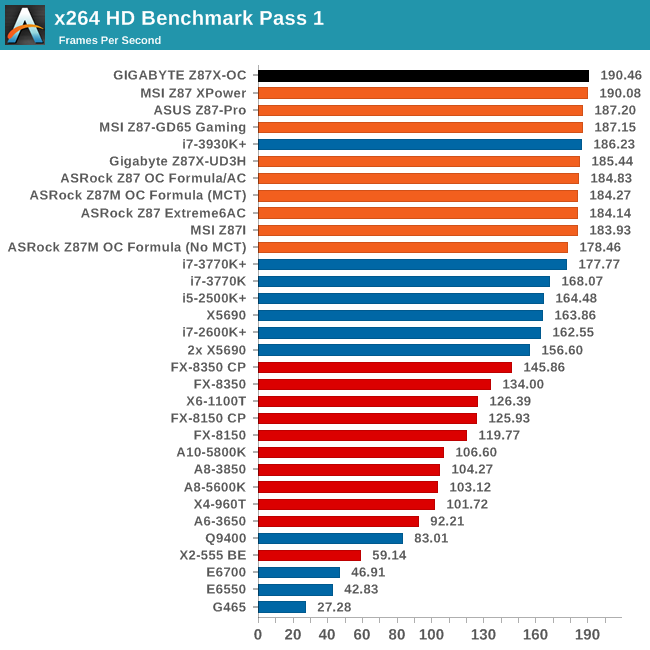
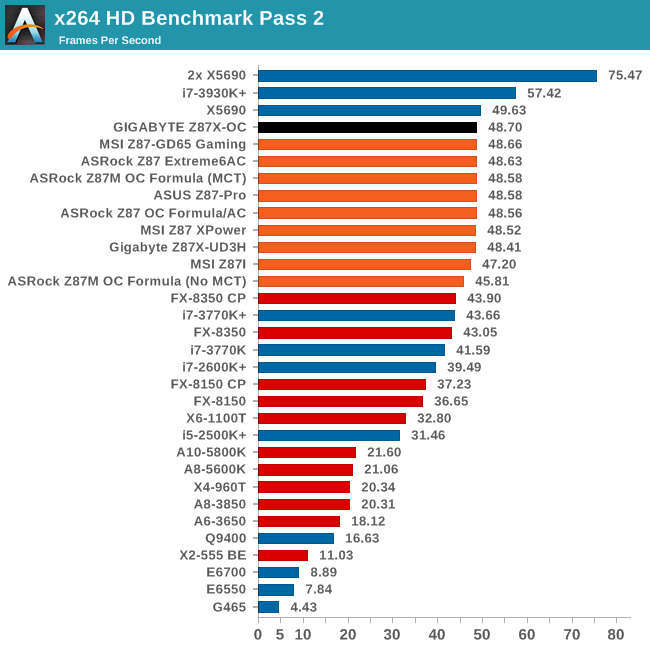
The Z87X-OC sets very good scores in our x264 test, both in Pass 1 and Pass 2.
Grid Solvers - Explicit Finite Difference
For any grid of regular nodes, the simplest way to calculate the next time step is to use the values of those around it. This makes for easy mathematics and parallel simulation, as each node calculated is only dependent on the previous time step, not the nodes around it on the current calculated time step. By choosing a regular grid, we reduce the levels of memory access required for irregular grids. We test both 2D and 3D explicit finite difference simulations with 2n nodes in each dimension, using OpenMP as the threading operator in single precision. The grid is isotropic and the boundary conditions are sinks. Values are floating point, with memory cache sizes and speeds playing a part in the overall score.
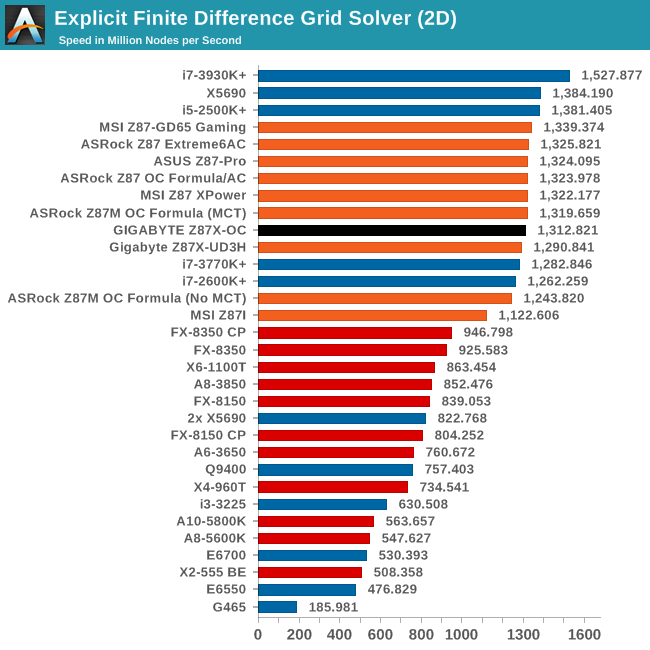
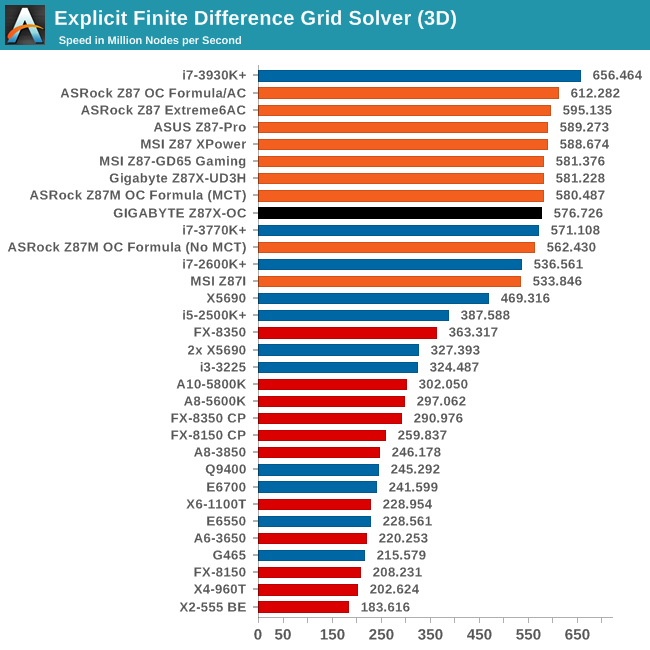
Interestingly enough the Z87X-OC is not a great performer at our explicit grid solvers that rely a lot on multi-level cache transfers.
Grid Solvers - Implicit Finite Difference + Alternating Direction Implicit Method
The implicit method takes a different approach to the explicit method – instead of considering one unknown in the new time step to be calculated from known elements in the previous time step, we consider that an old point can influence several new points by way of simultaneous equations. This adds to the complexity of the simulation – the grid of nodes is solved as a series of rows and columns rather than points, reducing the parallel nature of the simulation by a dimension and drastically increasing the memory requirements of each thread. The upside, as noted above, is the less stringent stability rules related to time steps and grid spacing. For this we simulate a 2D grid of 2n nodes in each dimension, using OpenMP in single precision. Again our grid is isotropic with the boundaries acting as sinks. Values are floating point, with memory cache sizes and speeds playing a part in the overall score.
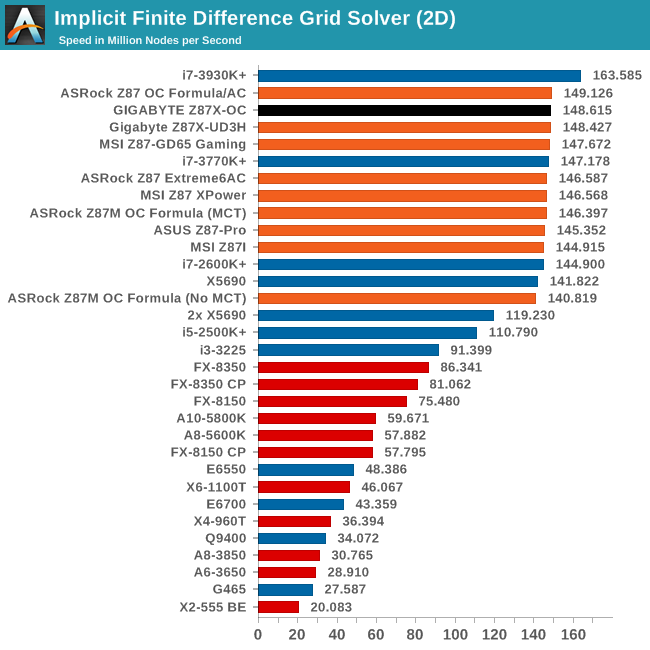
Despite the issues with the explicit solvers, when it comes to implicit calculations the Z87X-OC is near the top end again.
Point Calculations - n-Body Simulation
When a series of heavy mass elements are in space, they interact with each other through the force of gravity. Thus when a star cluster forms, the interaction of every large mass with every other large mass defines the speed at which these elements approach each other. When dealing with millions and billions of stars on such a large scale, the movement of each of these stars can be simulated through the physical theorems that describe the interactions. The benchmark detects whether the processor is SSE2 or SSE4 capable, and implements the relative code. We run a simulation of 10240 particles of equal mass - the output for this code is in terms of GFLOPs, and the result recorded was the peak GFLOPs value.
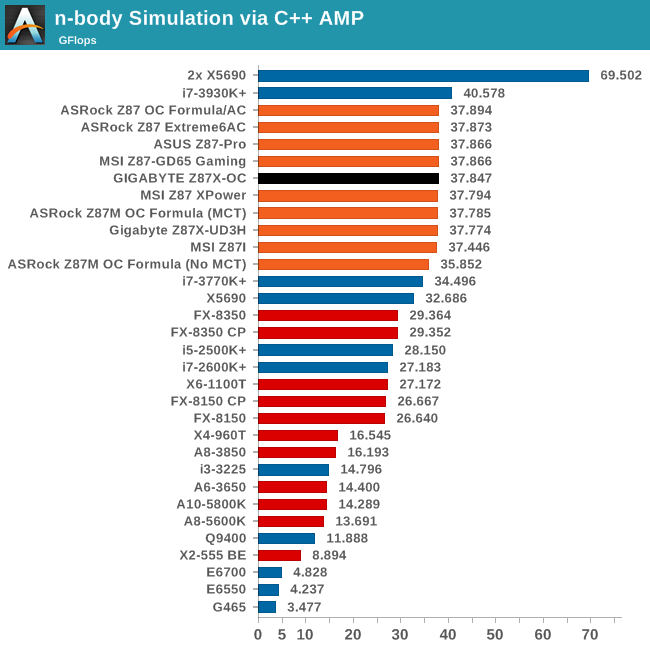










23 Comments
View All Comments
IanCutress - Friday, October 11, 2013 - link
With the last few generations, it's always been about 'have you got a good chip?'. A good OC chip of Ivy (or Sandy) has always been better than a bad chip this gen, and sometimes there isn't the certainty of getting a good chip this time around. That means the only jumps where it makes sense is when a bad chip in the newest gen beats your good chip. Each gen seems to give a 200-500 MHz IPC advantage (at 4GHz) depending on the CPU benchmark test (less in gaming), and you need to decide when that jump takes place if you're on the cutting edge of performance.But if you had a bad chip/ran at stock, then perhaps every two generations it makes sense to upgrade due to the IPC benefits. There are some pretty awesome low power chips this generation for example.
iTzSnypah - Friday, October 11, 2013 - link
I guarantee you that setting your Uncore to x34/35 will make the chip require less Vcore to be stable at any frequency.DanNeely - Friday, October 11, 2013 - link
Another use for the on board USB2 ports would be a thumbdrive to store bitlocker full disk encryption keys since the board doesn't appear to include a TPM keystore. Using an external USB port for that strikes me as mildly dangerous since it would be easy for someone to accidentally borrow the drive for something else.Nirvanaosc - Friday, October 11, 2013 - link
Hi everyone,I've read a lot of reviews already and most of the time I feel that the given motherboard is not enough or too much for what I need.
What would be the best for a day-to-day PC with a 4670K OCed and single GPU? This motherboard looks impressive but I think it's overkill for that purpose.
just4U - Monday, October 14, 2013 - link
It's different for everyone.. For me right now it's the G1 Sniper M5. While Anandtech has mentioned it I don't believe they've reviewed one yet.. I like the onboard sound/lan options which are not the generic Realtek stuff and tend to go matx.. but still want a board that's a cut above.. Asus also makes something similar in their Maximus6 Gene.vailr - Friday, October 11, 2013 - link
Did your board include the updated version Intel C2 chipset? And: did Gigabyte change the board version to 1.1, in order to indicate the presence of the updated C2 chipset? The review's photo shows board version 1.0.HardwareDufus - Saturday, October 12, 2013 - link
I really appreciate the inclusión of 2 HDMI ports instead of a DVI. I would love to find a Premium mini-ITX board that offered 2 HDMI ports.samsp99 - Saturday, October 12, 2013 - link
Does the audio codec really make that much of a difference these days? An old receiver for d2a, or a headphone amp like a fiio e10 solve that deficiency pretty well.CatheyBarrett48 - Saturday, October 12, 2013 - link
First time i trusted an online job add and managed to make 90$ in 5 hours... ℰxit35.comgenzai - Saturday, October 12, 2013 - link
I'm not sure what you mean by "for some reason only two of the chipset USB 3.0 ports are used. There are two USB 3.0 hubs for another eight USB 3.0 ports, and it seems..."If they used all 6 PCH SATA ports and put the FlexIO into PCIe, then they have 4 USB 3.0 ports to work with. 2 of those are routed directly to a FP header and then the other 2 each go to 4 port hubs to give another FP header and 6 rear ports. Seems perfectly logical and maximizes the available configuration.
g\